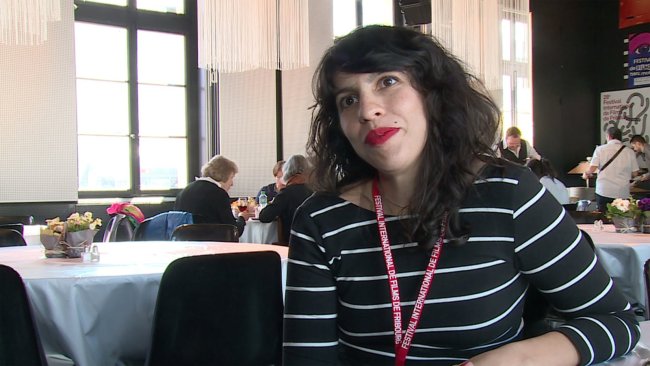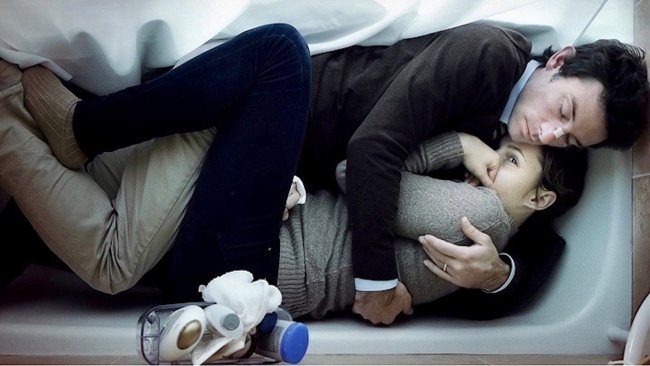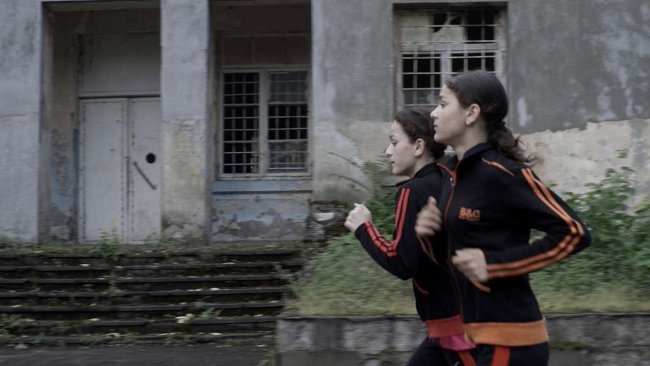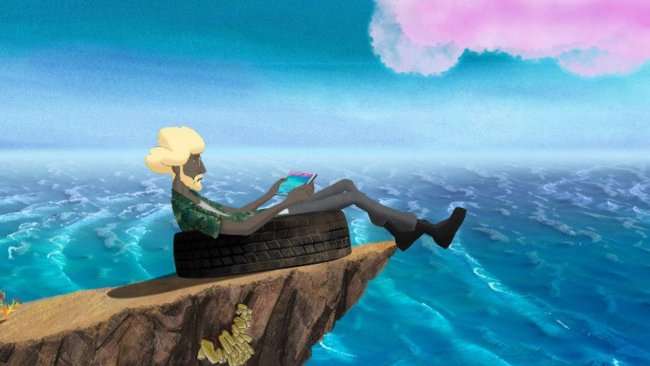Maya Da-Rin | A febre
[…] The narrative hesitations of a tale that is largely focused on expressive details contribute to this tropical hypnosis, which is far from being a simple geographical connotation. The hypnosis tells the often-silent story of the emergence of the awareness of an abused identity.
[…] «It’s not easy to be silent for a while, sometimes just opening a door can be the most difficult thing for an actor. Just being there, looking into the camera. The simplest can be the most complex. Just to stand in time.»
[…] «With cinema it is important we have this space to work, that things are not too attached to our own experiences, as it can be heavy sometimes. It is related to the idea of fabulating, how we fabulate our own lives.»
Text: Giuseppe Di Salvatore, Laura Davis
There are repetitions in Maya Da-Rin’s last movie, A febre - the back and forth of Justino between house and work. An indigenous man working as a guardian at the port of Manaus, for him the port is not the open door to a bigger world, but a gigantic cage that chokes his life with its bureaucratic spirit. Barbara Alvarez’ spectacular photography of the industrial port is a poisonous pleasure: a pleasure for our eyes, a poison for a man whose inner balance is still rooted in the ecology of the forest. Justino’s immutable shy smile reveals his docility to the rules of the “whites”, yet it often becomes a grimace of sorrow. The entire film is written on his ambivalent face, written as a hypnotic poem of both submission and resistance.
The narrative hesitations of a tale that is largely focused on expressive details contribute to this tropical hypnosis, which is far from being a simple geographical connotation. The hypnosis tells the often-silent story of the emergence of the awareness of an abused identity. The theme of the “domestication of the indigenous people” is not only explicitly touched on in the dialogues, but dramaturgically embodied by the role of Justino’s house and family. Apparently the counterpart of his working place (as the forest is the counterpart of the city), the house and the family will reveal themselves to be contaminated by the life style of the “whites”. The conflict between external submission and internal resistance becomes the entirely internal drama of a split personality. The daughter wanting to go studying at university, in Brasilia, and the brother’s family insistently asking him to come back to the village in the forest draw the span of the alternative that makes Justino ill.
Maya Da-Rin is quite intelligent in not making the film develop into an impossible either-or. Our cinematic journey into Justino’s dreams does not give us a univocal solution between indigenous traditions and white civilization. Justino’s healing from the fever coincides with his becoming aware of this dilemma, for awareness is the necessary backbone for any form of resistance.
Jair Bolsonaro’s indulgence towards the current physical extermination of the indigenous people in Brazil certainly overcomes the film’s focus on the theme of the domestication of the indigenous, and for this reason, Regis Myrupu (Justino)’s alarming claim on the Piazza of Locarno has given to A febre the role of being a vehicle of public complaint. It would be unjust, however, to reduce Maya Da-Rin’s film simply to this political message, as, thanks to her formal choices, she has built a film that primarily communicates on the level of purely cinematic experience. With A febre we sink into the perception of an indigenous man, we have the (not always comfortable) experience of being inside Justino’s skin. In this way, we will not just be the repository of a political message, but we will be pushed, as viewers, to undertake the exercise of listening to another culture, to another sensibility – which amounts to taking a concrete step forward towards respect of, and cohabitation with, the Other.
(Giuseppe Di Salvatore)
*
Interview with Maya Da-Rin
Laura Davis (LD): How did you cast the film? Who were you looking for?
Maya Da-Rin (MD): In the beginning I didn’t know where to start to find a family. I went to Manaus to think about the film, visiting indigenous communities, different people who speak different languages, who originate from different cultures, who live together in the same neighbourhood. We call them urban native villages, and then I went to one of these communities and stayed there for some time. I followed their day to day activities, going around the city, meeting other people, thinking about how the film could be built. I started to write on this experience of just walking around, being there without a highly fixed objective. I wasn’t looking for something specific, just trying to find out what this film could be. It was some sounds, some images, and then slowly something started to come together. I was hearing a lot of stories, from their parents and relatives or of their own lives, which I tried to incorporate in the narrative as well. Then I decided I wouldn’t work with a family that already exists, perhaps not everyone in the family would want to participate. I went to São Gabriel da Cachoeira near the frontier with Venezuela where I went to visit and talk with people. Then it spread by word of mouth. We went a second time, after they had time to assemble a group together. So, the cast came at this time.
LD: How did you introduce them to the camera?
MD: We tried some things together, looking into the camera, asking them questions about their life, trying certain movements, sometimes just being silent for a while, seeing how this could be supported. It’s not easy to be silent for a while, sometimes just opening a door can be the most difficult thing for an actor. Just being there, looking into the camera. The simplest can be the most complex. Just to stand in time. After that I invited some people who could assemble the family into a workshop, and then we worked together for three or four days.
LD: Can you speak about how you workshopped the script?
MD: We listened a lot to each other; we talked and then after that we had two months’ rehearsal and, as Regis was saying, we didn’t work so much on the script in the scenes. I read the scripts to them and then we improvised, working on different things, which opened an availability to do things after that. It was more about telling stories, listening to the others and being attentive, trying to be present and listen to the person who is speaking. An exercise of presence.
LD: How long did this take?
MD: We spent about two months doing this, sometimes working for hours and hours and hours. By repeating and repeating we had less control over things, we repeated things to arrive at new things that we weren’t expecting. Normally when we start working, we are all a bit nervous. To repeat things was a way of getting more comfortable with things, we stronger but more tired so sometimes we just let things go. This worked a lot better; we get an interesting acting tone rather than the freshness of doing something once. It was really tiring but we got to some things we couldn’t get to at the beginning.
LD: I know your last film (Lands, 2018 – Locarno Festival) was a documentary. Why do you choose to create characters?
MD: Somehow in cinema, even when we work in documentaries, we are creating characters. Even when we don’t intend to. Now things are working more on the border with documentary where people are playing themselves, but for me there is a character that is being built there. When there is a camera, there is something that is being constructed. Cinema is constructedness. We are always building a narrative or fabulating, telling a story somehow even if it’s abstract films.
LD: How did you develop these ideas in A febre?
MD: As the film was built and I start my process, I was listening to different people and different stories - it was natural to me to start to think of characters from these different narratives. Maybe if I had met a family from the very beginning the film could have been made with that family. The project started in 2006 when I shot some documentaries on the frontier between Brazil, Colombia and Peru. Then there was this one family that I met and we got really close, and from this relation the first idea came to me and then I met so many people that the characters were born from the people I met and I thought this gave me some kind of freedom, and that this could also give some kind of freedom to the people who were playing the characters. In the way that there are some things that you recognise and some things that are different about your life and this could open some space or room for you to play.
LD: This is how I feel about the film. I don't know if it’s just the English language but we have a tendency to think of filmmaking in terms of capture. “To capture a film”, whereas what you’re doing is a form of release. In the press conference, for example, the Regis said you helped him overcome his shyness, give him a form of openness and freedom.
MD: Becomes somehow when we are playing ourselves there is something about the way you want to appear that has a lot of weight.
LD: What do you mean by this?
MD: You build a character out of yourself, how other people are going to relate to it, and they are going to look for something that’s genuine. There’s a fetishism for what is genuine, and when we are talking about indigenous cultures it can be really strong, this fetishism, for genuine things. So, people somehow, the spectators are expecting to see the real indigenous people. What’s our real being? I don’t think I could tell; I am so many different things at the same time. I don’t know if I would feel comfortable if somebody would like to make a film about me. I have been asked before and I said no, I didn’t feel comfortable. I would feel more comfortable playing something in which I would have more space to play these characters.
LD: When did you realise this?
MD: This is not related to the question of my shift from documentary to fiction because when I did documentaries before, the people with whom I work… it was clear they were building characters for themselves. With cinema it is important we have this space to work, that things are not too attached to our own experiences, as it can be heavy sometimes. It is related to the idea of fabulating, how we fabulate our own lives.
LD: To me, the film – in both form and content – explores the imagery of capture and hunting. There is a lot about the chase that is not shown on screen. I was wondering how you resist this idea of capture in your film.
MD: I think we show too much, we don’t allow people to see things. There were some things in the story that I have never seen either, that I didn’t have direct access to, so I wouldn’t know how to show them either. There is also this idea that when you show things, everything that you show somehow fixes it, grabs it. To show the field of truth it depends on how it’s shown, but it can really reduce the field of perception. The field of perception, of imagination.
LD: How does this fit into your practice?
MD: In the workshopping stage I asked someone to tell a story and then asked someone to repeat a story. The same story they were hearing. It was really important everyone was attentive. Each time a person retold this story they are heard the story a bit differently. It became different for people who were listening. It was clear to us, and it really changed the images in our mind. We have been working a lot on the stories we tell to each other and for me it was really part of building the film. The images that we can make ourselves, the images that arose for me, that the film also brings to us. What is the idea that each one of us builds of the forest or village that Justino comes from? It’s something very personal, the image that each one of us can make of it. This is something that interests me when telling stories, the image that each one of us perceives from storytelling, and I think that is the power of cinema, that it can reach people in very different ways.
Locarno, August 2019
(Interview: Laura Davis, Locarno Critics Academy 2019)
This article contains a third-party video. If you would like to watch the video, please adjust your settings.
Info
A febre | Film | Maya Da-Rin | BRA-FR-DE 2019 | 98’ | Locarno Film Festival 2019
Best actor (Regis Myrupu) at Locarno Film Festival 2019
First published: August 26, 2019







